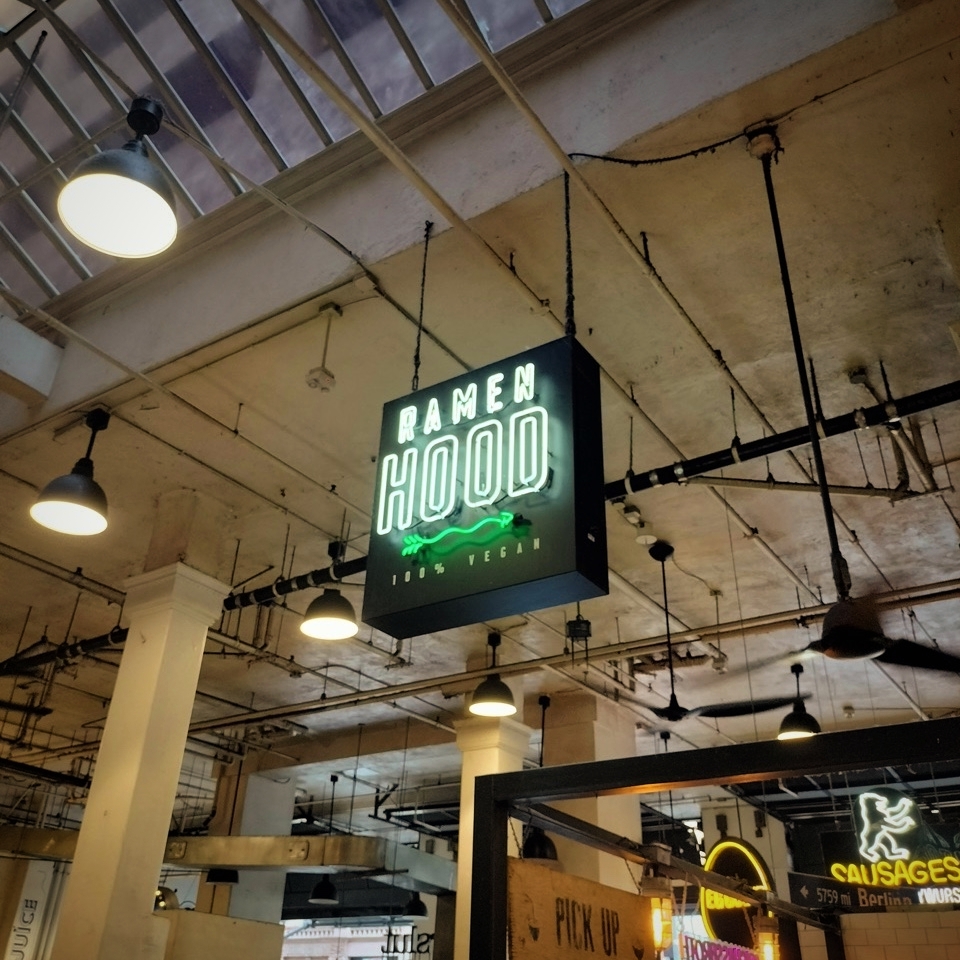In the late 1910’s Grand Central market was an up and coming spot for locals and restaurant industry workers to grab a bite and shop California’s agricultural delights. Though its popularity had flagged in more recent years, a mid 2010’s revitalization turned it into one of the preeminent foodie playgrounds in the country. Approaching from the Hill Street side of the market, superlatives fly off various signs and menus in an attempt to tease my wife and I away from our destination. Sights and smells abound1. Marking our arrival to Ramen Hood is a red neon sign reading #richassbroth, a valiant effort to meet the energy of their environment.
From a seat at the counter there’s little visual interest beyond said neon sign, and the seven demure lucky cats on the noren dividing the bar from the back kitchen. The energy is tempered and the trappings all very utilitarian; the most dynamic element is a single running faucet on the dipper well which gives their front kitchen the feel of an industrial water garden. Only the bare necessities are available on the countertop trays – – chopsticks, napkins, and S&B shichimi togarashi. The menu at the register is short and easy to parse, and my wife and I confidently order a bowl of garlic ramen, a bowl of spicy garlic ‘katsu’ ramen, and the ahi ‘tuna’ crisps to share.

Our appetizer arrives as vessels of crispy rice with beet-based ‘spicy tuna’ and silky yuzu-avocado puree piped in. It’s sweet and light, with pearls of minced beet almost fully suspended in the spicy mayo – – a playful interpretation of a unique texture. It’s also quite mild, and the acidity that a bolder chili paste might typically bring is instead provided by the delicate yuzu avocado puree. It’s the sort of dish guaranteed to send amateur home chefs straight into reverse-engineering mode after a single bite.
The ramen cuts a dashing figure, nori sheet poking out like a gentleman’s handkerchief. In the garlic ramen, the white miso lends it an opaque look. The roasted sunflower oil in the broth forms a thin sheen on the surface, but this is no exxon valdez situation like you might expect in a tonkotsu broth. A nest of chili threads perches on top, and a cluster of blanched bok choy bathes off to the side. The noodles are kinky and chewy, the mung bean sprouts are vibrant, and the king oyster mushroom cross sections have a lovely bite. The unheralded star is the handful of roasted garlic cloves swimming throughout. Because of their middling buoyancy the hunt for each clove becomes a full-on trawl, and as tasty as the noodles and sprouts are they are quickly relegated to bycatch.
The spicy garlic ‘katsu’ ramen is similarly constructed, sans garlic cloves but with added hot oil and omnipork. The plank of ‘pork’ suits the bowl nicely, but unfortunately the hot oil somewhat overpowers the flavor of the broth – – it’s not all that spicy, but while the broth is admittedly rich it still has quite a delicate profile. A few shakes of togarashi give it some more zip and help it lean into its working-class proclivities.
My wife and I opted into the vegan egg, which proves to be the right move. The white is formed by gelling their broth base with agar agar and seasoning it with sea salt; the yolk brings some umami with nutritional yeast and black salt, and is spherified with sodium alginate. Not only is this ‘egg’ a loving ode to the witchy properties of kelp, but it emphasizes taste over fidelity. It’s objectively more flavorful than the chicken byproduct it’s inspired by.

At the end of the day, a bowl of ramen is only as good as its broth. Given the way that ramen broth is traditionally made I expect that vegan ramen shops invite disproportionate scrutiny. The ramen I loved as an omnivore was superlative to the point of being superfluous – – fatty, salty, gregarious and devil-may-care. This ethos seemed misaligned with my pivot towards more conscious and healthy dining, and in seeking a proper vegan ramen I worried that I was chasing a ghost. Ramen Hood has designs on subverting our preconceptions while also staying true to its subtler intentions. Here, the broth is indeed rich enough to thumb its nose at the haters without crossing into decadent. Its flavor is light yet confident, and the dregs can be thrown back without committing to the sodium sweats.
Some plant-based interpretations of classic dishes will, in an effort to shed the aura of rabbit food, send the pendulum much too far in the other direction2. Ramen Hood shows admirable restraint in this regard. Not only is it a wonderful meal but, neon sign aside, they take a more secure approach to plant-based dining that will serve the vegan food scene well.
- The Grand Central Market sensory experience is a bit hostile to herbivores; many of the old-school stalls serve meats from cafeteria trays behind clear glass. Certain angles of approach are less grisly than others. For those willing to make the journey and wanting to claim a vegan space in the historic heart of Downtown LA, approaching from the southeastern corner of the market off Broadway might be your best bet. ↩︎
- The overly rich presentations of some modern vegan adaptations are the gastronomic equivalent of an EV Hummer. Folks, we have nothing to compensate for. ↩︎

